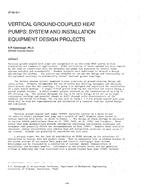Click here to purchase
Activating the thermal mass of a building by implementing Thermally Active Building Systems (TABS) assists in reducing energy use for thermalmanagement of buildings by utilizing a low temperature heating and high temperature cooling approach. Coupling TABS with geothermal heat pumpsthat use low-grade energy source in addition to model-based predictive control (MPC) helps to further decrease energy use. Most equipment in hybridGEOTABS buildings follow a modular structure that can be classified as low, medium and high temperature sources, and emission systems dependingon the building type and needs. This work describes the main characteristics of the individual modules and interfaces of hybrid GEOTABS buildings,and provides examples of three types of buildings that use the hybrid GEOTABS approach. These buildings are an elementary school in the CzechRepublic, an elderly care home in Belgium, and an office building in Luxembourg. Although these buildings are functionally different, the generic hybridGEOTABS concept can be abstracted based on a detailed consideration of the interaction between energy transfer systems (e.g. geothermal heatexchangers, heat pumps, boilers) and emission systems (e.g. TABS, air handling units, radiators, domestic hot water). This work defines the genericconcept, individual modules, and interfaces between related components of hybrid GEOTABS, enabling the specification of a design template with a“minimum” number of required operational parameters. Such a template can enable fast sizing of major system components, consistency between designbuildoffers, and facilitate effective integration of the Hybrid GEOTABS into new buildings.
Citation: 2019 Winter Conference, Atlanta, GA, Conference Papers
Product Details
- Published:
- 2019
- Number of Pages:
- 8
- Units of Measure:
- Dual
- File Size:
- 1 file , 1.2 MB
- Product Code(s):
- D-AT-19-C009


